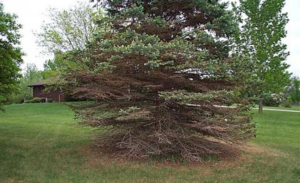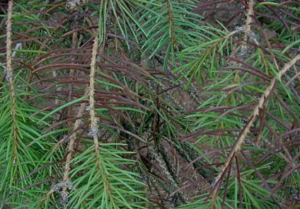Needlecast
Needlecast is a fungal disease commonly found on blue spruce trees that will cause needles to turn brown, fall off and leave bare patches to the tree. It can also be found on fir, pine and hemlock species. Typically symptoms first appear on the lower branches of a tree and work from the inside of the tree out.
The disease is common in the Spring and optimal conditions are during times of excess moisture and humidity. Needlecast is more detructive on spruces planted in shaded settings or in tight hedgerows. Blue spruce, white spruce and oriental spruce are the most severely affected, while Norway spruce and red spruce are more resistant to the disease.

Treatment
Once needles are infected they cannot be healed or cured and will eventually fall off of the tree. While there are fungicides that help to manage this disease, the main use is in protecting new needles from the fungal pathogen. Look for copper or chlorothaloni as the active ingredient. Fungicides should be applied in the Spring when new growth is ½ inch long and then again on regular intervals should wet weather persist. Autumn fungicide applications may also be necessary.
